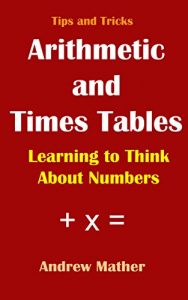This book is intended to illustrate some of the basic tips and tricks of arithmetic that may help you or your child be more comfortable with the times table. They are useful far beyond elementary school and I have used them as an adult to get by before calculators were available, and now when they are not readily available.
They are neither exhaustive nor authoratitive but they are accurate and they do work. If you find them useful, then I am delighted.
I do not know precisely how and when children are taught their times tables, but this approach relies mainly on addition which is a natural adjunct of learning numbers and arithmetic, so I hope the techniques will be compatible with your child’s education.
Beyond addition, a familiarity with multiplication and subtraction are useful, but not critical.
There is no singular correct way which must be learned, when dealing with numbers. What is most useful is to have a box of tools, just as in DIY, and to use the tool that is most convenient. To that end, there will often be many ways to arrive at the answer, which will be the same in any case.
Memory is useful, and necessary for the smaller numbers, but it does not substitute for understanding. Memory may allow you to recall the answer to 11 x 12 but will it allow you to remember 123 x 420 or 248024 x 482058 if you have never seen that before?
Times tables are rightly considered a building block in familiarity with numbers and arithmetic. The value of the tips and tricks is that it allows us to build tools that will be useful far beyond the basic tables.
They are neither exhaustive nor authoratitive but they are accurate and they do work. If you find them useful, then I am delighted.
I do not know precisely how and when children are taught their times tables, but this approach relies mainly on addition which is a natural adjunct of learning numbers and arithmetic, so I hope the techniques will be compatible with your child’s education.
Beyond addition, a familiarity with multiplication and subtraction are useful, but not critical.
There is no singular correct way which must be learned, when dealing with numbers. What is most useful is to have a box of tools, just as in DIY, and to use the tool that is most convenient. To that end, there will often be many ways to arrive at the answer, which will be the same in any case.
Memory is useful, and necessary for the smaller numbers, but it does not substitute for understanding. Memory may allow you to recall the answer to 11 x 12 but will it allow you to remember 123 x 420 or 248024 x 482058 if you have never seen that before?
Times tables are rightly considered a building block in familiarity with numbers and arithmetic. The value of the tips and tricks is that it allows us to build tools that will be useful far beyond the basic tables.






